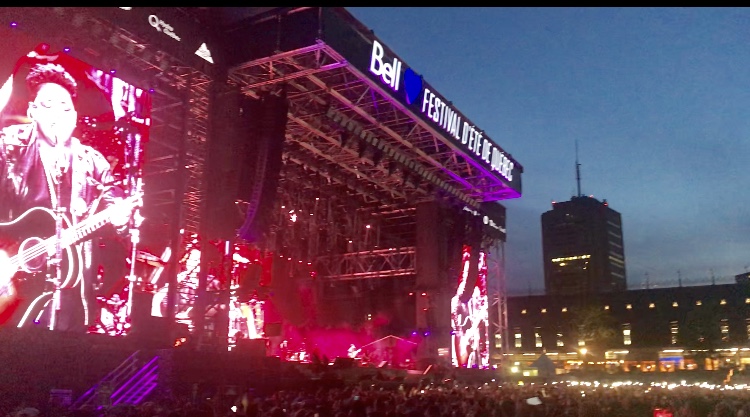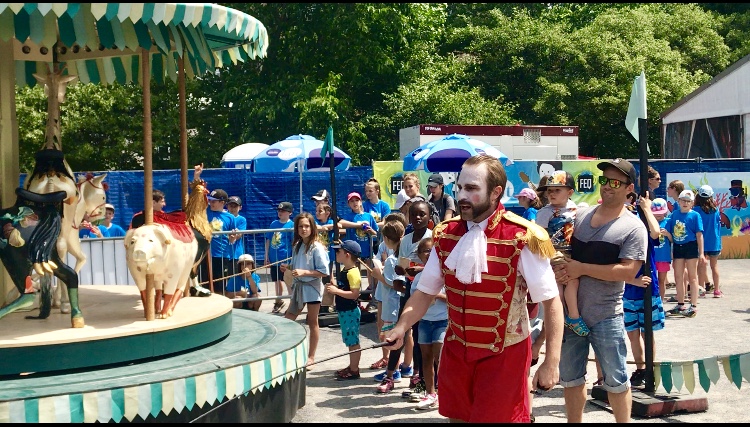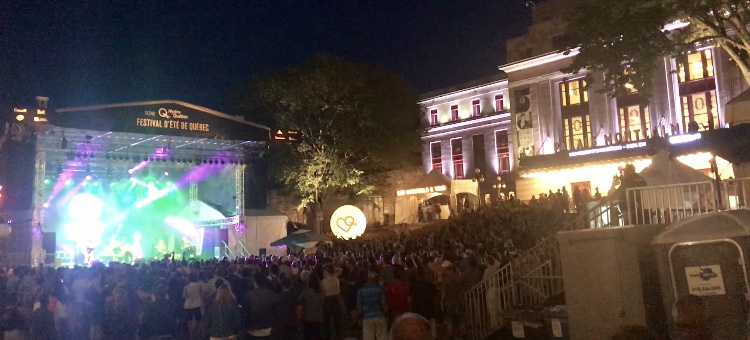

People turn out in droves each July, in North America’s only historic walled city, to see and hear 11 days of simultaneous concerts on multiple stages at Canada’s most important music festival: Festival d’ete de Quebec.
Festival d’ete de Quebec
Miriam-Webster defines “droves” as “a large number; a crowd.” That large number is 90,000 people who walk from every direction through town and onto the Plains of Abraham to be a part of a nightly on-stage spectacle. There is one giant set of “season ticket” bleacher seats, but for the most part people stand in the expansive, grassy natural bowl of an amphitheater and sway to the songs under the stars.
The temporary stage – thought to be the largest on the continent – looms like a new office building over the sea of spectators. It’s huge – but the ticket prices aren’t. About $100 will get you a pass for all 11 nights of music on open-air stages – most within walking distance – all over the scenic city. The venues vary in space but each setting is a stage in itself – such as a backdrop of medieval architecture or a theater marquee.
Superstars and Rising Stars Sing Under the Stars

Over the years big names have taken the main stage including Lady Gaga, Elton John, Celine Dion, and Paul McCartney who, according to tourism official Nancy Dacres, so enjoyed Quebec City he came in a day or two early and could be seen pedaling his bicycle around town.
Slipknot, Buddy Guy, Mariah Carey and Eric Lapointe, the most successful male music artist in French Canadian history, were among the major acts on the main stage in 2019 while the smaller stages spotlighted international acts, up-and-comers, and some recognizable stars such as the Village People and the Strumbellas. The festival includes some free shows and a colorful children’s carnival area.


The nice thing about the mainly evening scheduling of the bands and performers, which conclude at 11 p.m., is that it leaves all day for the locals to work and for everyone to enjoy the French-speaking city’s historical sites, scenery, culinary offerings and charming streets.
Three Ways to Find Your Way Around Quebec
I suggest three ways to get the lay of the land upon arrival in Canada’s oldest city, which is reachable via its own nearby airport or by bus or car from the airport in Montreal (it’s about a two-hour drive.)

First, Quebec City spills down to the St. Lawrence River, including an escarpment, which is why the fortified spot was desirable and defensible in the first place. The streets and sidewalks are hilly, and an inclinator provides passage from behind the stately Fairmont Le Chateau Frontenac down to Quartier Petit Champlain/Place Royale, the most quaint and European section of this very French city. But for full perspective, Le Bus Rouge, which begins near the Fairmont, can give you an open-air, rolling view of Quebec City and its sites so you may get your bearings.
Secondly, to span the scene and the years while sitting in one spot, Immersion Quebec is a new, virtual reality interactive experience in which, with goggles on, you’ll feel like one of the first settlers. Understanding the past will allow you to see the city through a historical lens and you stroll through the streets enjoying the sound of the occasional accordion player squeezing out French melodies like “La Vie En Rose.”
Third, if you prefer a genuine birds-eye view, Le 23, on the 23rd floor of the Hilton Quebec, is the place to visit. Le 23 is located in Old-Quebec’s Saint-Jean-Baptiste Upper Town, which is the highest point from which you can see all the intricate structures and streets of Old Quebec, the Plains of Abraham, and the St. Lawrence River far below.

A look down across the street provides a panorama of Quebec’s National Assembly Parliament Building, a stately, detailed, French-style chateau. Though the building is classical, the grounds, a park with a fountain and statues, is pleasant as is the new front-and-center visitors entrance which leads to a circular, surprisingly contemporary, artistic and even space-age interior passage.
Fear not, though, the expected fanciful majesty of government still exists inside and the normally closed doors are now open at Le Parlementaire, the restaurant inside the very halls of power that for decades has served legislator lunches and still does.
Hilton Quebec Closing For a Year of Renovations

Be advised, though, the Hilton Quebec is set to close beginning in 2019 for an extensive one-year interior and exterior renovation. As an iconic high-rise hotel looming over the city from a prime location on Parliament Hill and connected to the Centre des congress de Quebec convention space, this is a celebrated investment, indeed. Sure it was functional but the drab, dark, utilitarian property had become dated and lacked the charm and sense of place to represent Quebec. The Hilton’s eventual reopening is sure to be a true reawakening.

You may choose to stay down below along the river in the oldest part of the city in Quartier Petit Champlain/Place Royale, which is such a French time capsule Steven Spielberg used it to shoot a Parisian scene in the film “Catch Me If You Can.” The oldest stone church in North America – Notre-Dame-des-Victories – was erected there in 1688. If you do, Hotel 71 is a stylish stunner with common areas for espresso, an automatic wine and spirits dispenser, and Il Matto, an authentic Italian comfort food even serving a selection of grappa.
Quebec Culinary Considerations
Of course Quebec is famous for Poutine (French fries, cheese curds and gravy), and you can have it if you must, but you will have many alternatives. Varied yet colorful options in unique yet convenient locations include: Il Teatro for high-end Italian in an indoor or outdoor setting; Boulangerie Paillard is a bustling brasserie in the heart on rue St-Jean in the heart of a vibrant shopping district midway between Parliament Hill and the Fairmont Chateau Frontenac where, just across the street, you can sit outside or inside at Chic Shack for a casual meal and great people watching in the shadow of the most photographed hotel in Canada. There is often spontaneous live entertainment on the promenade near the funicular station.
For Americans, part of the charm of Quebec is the international feel. Therefore, get in the spirit and learn at least a few French phrases before you go. You can get by with only English, but it is more fun and respectful to be able to greet, thank, and bid adieu to the very friendly inhabitants you will meet there.
Michael Patrick Shiels is a radio host and travel blogger. Follow his adventures at GoWorldTravel.com/TravelTattler. Contact Travel Writer Michael Patrick Shiels at [email protected]
- Ashford Castle Hotel, U2’s Bono and Why Visting Ireland is So Entertaining - March 28, 2024
- Solo Travel to Oceania Cruise Ports St. Barth’s and Barbados Became Authentic Cultural Encounters - February 27, 2024
- Event Planning Star Tiffany Davis Visits 20 Beverly Hills Special Spots in 20 Days - February 18, 2024
